Smartphone sales have exploded in recent years and are expected to surpass 420 million units worldwide, representing nearly 30 percent of all mobile phones sold this year. The study from IMS Research also indicates that annual sales will exceed one billion units by 2016, accounting for one of every two phones sold.
Pioneers in the smartphone market like Palm's Treo helped pave the way for today's success. It was a slow and bumpy road initially but once wireless capabilities caught up and devices were subsidized more heavily, momentum took over from there.
"But despite the higher margins for smartphones, and the seemingly insatiable consumer appetite for converged devices, it is clear that not all OEMS are equally positioned to capitalize on this market trend," says Josh Builta, analyst in IMS' Mobile Technologies Group. "For instance, LG, despite being the third largest OEM in the world, has offered a fairly limited smartphone portfolio in recent years, a factor that resulted in the company reaching less than a three percent share of the total smartphone market in 2010."

The smartphone landscape has changed drastically over the past few years and has proven that if you can't provide innovative handsets to consumers, you will quickly fall behind. For example, Nokia held an estimated 40 percent market share in Q1 of 2010 but only a year later, that number dropped to only 24 percent. BlackBerry maker RIM has also seen their market share decline, from 20 percent in 2010 to only 15 percent this year. Their recent announcement to cut 2,000 jobs worldwide likely won't help matters either.
Others like Apple, HTC and Samsung have seen tremendous growth as these companies remain on the cutting edge of smartphone technology. Samsung saw the largest share increase, jumping from 3 percent up to 13 percent over the course of a year. Apple's iPhone brand has been met with overwhelming success and helped to shape phones from other manufacturers.
Do you use a smartphone and if so, what kind?